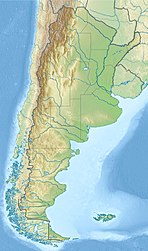| Colorado Basin | |
|---|---|
| Cuenca del Colorado | |
| Coordinates | 41°30′S 61°00′W / 41.500°S 61.000°W |
| Etymology | Colorado River |
| Country | |
| State(s) | Buenos Aires & Río Negro Provinces |
| Cities | Bahía Blanca, Viedma |
| Characteristics | |
| On/Offshore | Both |
| Boundaries | Ventania High (N) Argentina Basin (E) Rawson/Río Negro High (S) San Rafael Block (W) |
| Part of | South Atlantic rift basins |
| Area | ~180,000 km2 (69,000 sq mi) |
| Hydrology | |
| Sea(s) | South Atlantic |
| River(s) | Río Negro & Colorado Rivers |
| Geology | |
| Basin type | Passive margin on rift basin |
| Plate | South American |
| Orogeny | Break-up of Pangea |
| Age | Early Cretaceous-Quaternary |
| Stratigraphy | Stratigraphy |
| Field(s) | none |
The Colorado Basin (Spanish: Cuenca del Colorado) is a sedimentary basin located in northeastern Patagonia. The basin stretches across an area of approximately 180,000 square kilometres (69,000 sq mi), of which 37,000 square kilometres (14,000 sq mi) onshore in the southern Buenos Aires Province and the easternmost Río Negro Province extending offshore in the South Atlantic Ocean.
The basin comprises a sedimentary succession dating from the Permian (pre-rift stage) and Early Cretaceous (rift stage) to the Quaternary, representing the passive margin tectonic phase of the basin history. The Mesozoic rifting in the basin resulted from the break-up of Pangea and the formation of the South Atlantic. Long hiatuses exist in the succession.
The basin is of paleontological significance for hosting fossiliferous stratigraphic units dating to the Late Miocene. The Arroyo Chasicó Formation defines the Chasicoan South American land mammal age and contains a rich mammal and other vertebrate fauna. The contemporaneous Cerro Azul Formation has provided fossil rodents, armadillos and opossums. The Middle to Late Miocene Gran Bajo del Gualicho Formation contains vertebrate fossils of the cetacean Preaulophyseter gualichensis. The Río Negro Formation has provided fossils of the glyptodont Plohophorus figuratus. The Permian succession in the basin has provided flora microfossils.
Contrasting with the South Atlantic passive margin basins to the north (Santos Basin in southern Brazil) and south; Golfo San Jorge and Austral Basins, the Colorado Basin does not produce hydrocarbons. Exploration for petroleum started in the 1940 with the drilling of two onshore wells and several onshore and offshore wells have been drilled in the 1960s, 1970s and 1990s. The main source rocks are found in the Permian succession, with reservoir rocks the Colorado Formation. Seals are provided by the Early Paleocene Pedro Luro Formation.
